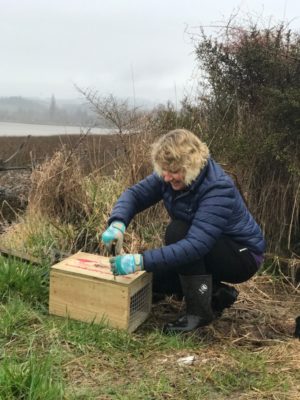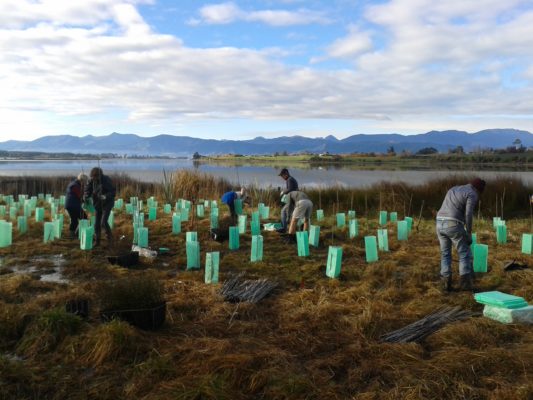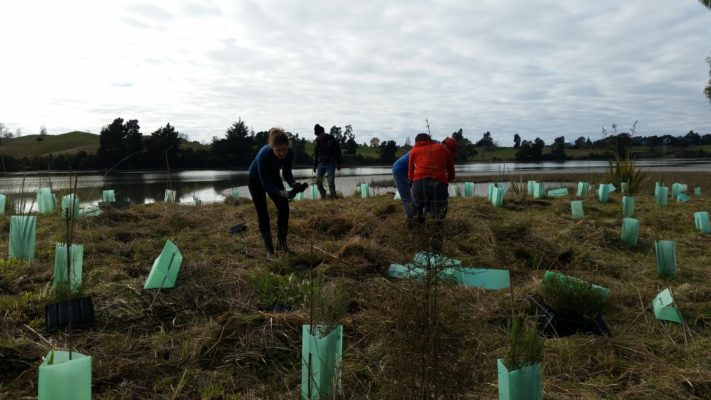Tracey Murray, Trapping Field Officer for ‘Battle for the Banded Rail’ recently bought 150 mesh tea-strainers online, importing them from a manufacturer in China. So what does anyone do with 150 mesh tea-strainers?
Tracey handed them out to her volunteer trappers at a recent ‘Trapping Workshop’ get-together – and not because her volunteers enjoy a good ‘cuppa’.

“You put the bait inside the tea-strainer,” Tracey explains. “We aren’t targeting mice but mice have been taking our bait and don’t set off the trap. The mesh stops the mice getting it so we don’t have to keep replenishing it as often Using the mesh strainers also prevents wasps eating the baits over the summer months when they are also a problem.”
Now there’s a novel hint for community groups. Has your group tried tea-strainers?
Tracey is employed part-time by the Tasman Environment Trust to manage and support volunteer trappers in the ‘Battle for the Banded Rail’ project around the Waimea Inlet. It all started when she started monitoring a trapline on her own property on the edge of the inlet.
“Then I got involved in planting and habitat restoration,” Tracey explains, “And I was approached to manage the volunteer trapping. I’ve been doing it for about 18 months. We’ve got 56 volunteers who manage 630 DOC 200 traps. There’s a total of 56km of traplines.”
Many of the traplines are on private property bordering Waimea Inlet and are managed voluntarily by the property owners, so there’s a real mix of ages among the volunteers.
“People are encouraged to check their traps every 2-4 weeks,” Tracey says. “The number of traps varies. Most people have 20-25 traps they’re responsible for, but some have up to 40.”
As well as trapping around the edge of the estuary from the Mapua township to Best and Bell islands, there is an inland buffer of traps about 0.5km from the inlet edge to help stop reinvasion.
“We mostly catch rats – about 80% of the catch is rats,” says Tracey, “The rats love hiding in the flax. We also target stoats, weasels and hedgehogs and use dehydrated rabbit ‘Erayz’ bait (from ‘Connovation Ltd’). I make sure the volunteers always have some on hand. Some people add eggs if they have them, to attract stoats and weasels. If they haven’t caught anything for a while, some of the volunteers have been trying peanut butter which is particularly attractive to rats.”
Trapping around a tidal inlet isn’t always easy.
“At the edge of the estuary you have to walk in mud that can be deep,” says Tracey. “You have to wait until low tide to get around the edges in some places. And some of the traplines include traps hidden in gorse which makes them difficult to get to..”
About 25 volunteers attended the recent workshop and Tracey hopes to run similar workshops twice a year.
“The workshop was to remind people about techniques, methods of trapping, maintenance and health and safety. Ivan Rogers from DOC talked about his projects and about techniques and common misconceptions about trapping. He recommended sticking to one bait at a time rather than always changing to different types of bait,” says Tracey. “Ivan also said not to be afraid to move traps if they’re not catching anything – move to where there are rat and stoat tracks through the grass.”
Abby Boffa from Mapua Dawn Chorus gave volunteers an update on Mapua’s Kiwibank-sponsored backyard trapping programme and Gillian Bishop, Chairperson of the Tasman Environment Trust, spoke about the overall ‘Battle for the Banded Rail’ project. The workshop was also a chance for volunteers to socialise – since most of their volunteer trap checking is solitary work.
“People swapped stories, shared techniques and talked about their biggest rats!” says Tracey. “It was also a chance to talk to volunteers about our plans to extend the traplines next year. We’re going to extend traplines on Bell and Best islands in the inlet. Bell Island is only accessible by causeway at low tide. We’re also planning to add infill trapping on the Hoddy Peninsula.”

As well as trapping predators, volunteers for ‘Battle for the Banded Rail’ also carry out habitat restoration around the Waimea Inlet.
“Kathryn Brownlie is in charge of the habitat restoration side,” says Tracey. “Volunteers have planted 7000 plants this year. Most of the plants are supplied by Titoki Nursery at Brightwater, but Salisbury School in Richmond also grow some plants for us as part of a project.”
Habitat restoration planting started about four years ago.
“There are nine key sites for habitat restoration where banded rail have already been observed. We want to improve survival and increase nesting sites,” says Tracey. Although we are targeting the banded rail, we are also improving habitat for other estuarine birds such as fern bird and bittern.
The group has begun carrying out 2-yearly sight surveys of banded rails – the most recent in January 2017 – and plans to begin 3-yearly surveys of fernbirds, using recorded calls, in January 2018.
“We’ve done two banded rail surveys so far – identifying birds by sight and by footprints – and there has been a small increase in numbers,” says Tracey. “Some birds are also expanding into a new site in response to the planting. Banded rails are very secretive birds though – they hide in the rushes and are rarely seen in the open, so they need a reasonable area of rushes growing with some fresh water coming in. That’s because their main food is estuarine snails and the snails need fresh water coming from a stream or seepage.”

It’s still early days for the project – but there is plenty of scope for expansion as time, budget and volunteer-availability allows.
“At the moment we’re mainly trying to protect ground-nesting estuarine birds,” says Tracey, “So we’re aiming to trap the predators that raid the nests for eggs, as well as attack the birds themselves.”
Currently traps are set over two thirds of the estuary, plus inland buffers. Over 2000 catches have been recorded to date. It’s very satisfying for the volunteers to feel as though they are making a very real difference to the survival of these birds.

